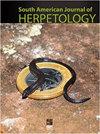栖息在新热带溪流中的蝌蚪的生态群落表现出不同的形态特征
IF 0.7
4区 生物学
Q4 ZOOLOGY
引用次数: 0
摘要
摘要蝌蚪在生态学和形态学上都有很大的差异。它们的生态形态变异可以通过基于特定性状的分类方案或代表生态差异的量化性状来表征。在这里,我们描述了栖息在大西洋森林溪流中的蝌蚪的生态形态空间,并将其与广泛使用的生态形态协会分类方案进行了比较。通过幼虫身体平面图、口盘位置和鞭毛存在的线性测量来量化生态形态特征。我们记录了19种蝌蚪,分为7个生态群落。Nektonic和neustonic物种与剩下的公会明显分离。尽管如此,生态形态变化的海底浮游生物轴在浮游生物和海底物种之间具有中介关系。聚类方法未能检索到生态形态群落,主要是因为没有识别出底栖专业群落之间的差异。因此,尽管通常使用生态形态特征来表征蝌蚪的功能多样性,但似乎需要替代特征来实现这一目标。本文章由计算机程序翻译,如有差异,请以英文原文为准。
Ecological Guilds Display Different Morphological Traits in Tadpoles Inhabiting Neotropical Streams
Abstract. Tadpoles display a wide variation in both ecology and morphology. Their ecomorphological variation can be characterized by classification schemes based on specific traits or quantifying traits representing ecological differences. Here, we describe the ecomorphospace of tadpoles inhabiting Atlantic Forest streams and compare it to a widely used ecomorphological guild classification scheme. Ecomorphological traits were quantified from linear measurements of the larval body plan, oral disc position, and flagella presence. We recorded 19 tadpole species classified into seven ecomorphological guilds. Nektonic and neustonic species were clear-cut segregated from the remaining guilds. Nonetheless, the benthic-nektonic axis of ecomorphological variation harbors an intermediary guild between the nektonic and the benthic species. A clustering approach failed to retrieve the ecomorphological guilds primarily by not discerning differences among benthic specialized guilds. Hence, despite the common application of ecomorphological traits to characterize tadpole functional diversity, it seems that alternative traits are necessary to achieve such a goal.
求助全文
通过发布文献求助,成功后即可免费获取论文全文。
去求助
来源期刊
CiteScore
1.50
自引率
0.00%
发文量
10
期刊介绍:
The South American Journal of Herpetology (SAJH) is an international journal published by the Brazilian Society of Herpetology that aims to provide an effective medium of communication for the international herpetological community. SAJH publishes peer-reviewed original contributions on all subjects related to the biology of amphibians and reptiles, including descriptive, comparative, inferential, and experimental studies and taxa from anywhere in the world, as well as theoretical studies that explore principles and methods.

 求助内容:
求助内容: 应助结果提醒方式:
应助结果提醒方式:


